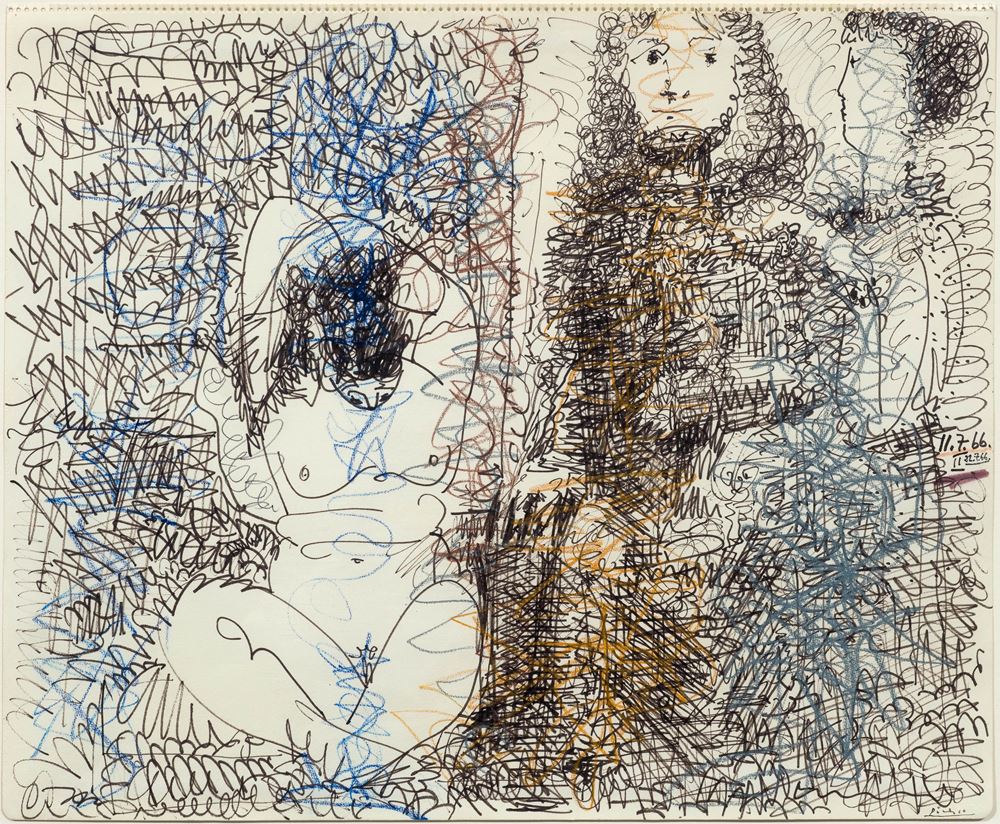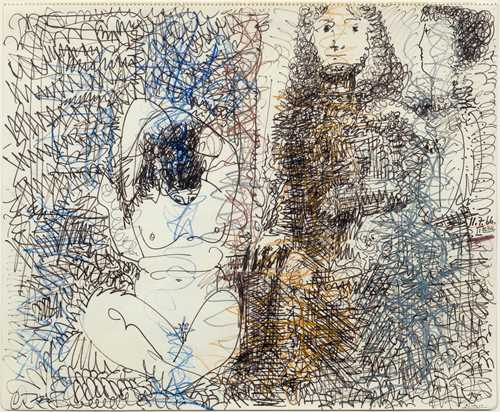
Lot 3256* - A191 Art Impressionniste & Moderne - vendredi, 06. décembre 2019, 16h30
PABLO PICASSO
(Málaga 1881 - 1973 Mougins)
Trois personnages. 1966.
Crayon and felt pen on paper.
Dated twice centre right:11.7.66 / II 22.7.66, as well as signed lower right: Picasso.
50 x 61 cm.
Provenance:
- Louise Leiris (with label on the reverse).
- Christie's, London, auction 30 June 1981, lot 1964.
- Private collection Germany, acquired at the above auction.
Literature:
- Zervos, Christian: Pablo Picasso, vol. XXV, p. 111, no. 222 (with ill.).
- The Picasso Project (ed.): Picasso's Paintings, Watercolors, Drawings and Sculpture: The Sixties II, 1964-67, San Francisco, 2002, no. 66-079, p. 253 (mit Abb.).
The juxtaposition of figures plays a central role in many of Picasso’s works, as is the case in the present work. In the epochal painting "Les Demoiselles d'Avignon", regarded as the initiation of Cubism par excellence, the five women already correspond more to compositional elements, as in Cézanne's portrayals of bathers, hardly connected to one another in the Cubist play of distortions and different perspectives. In the later significant series of paintings titled "Les Femmes d’Alger", Picasso concentrated on different variations of the corresponding model, a harem scene by Eugène Delacroix from 1834. Again, the figures stand, sit and lie independently of one another. However, in Picasso's late work, an increasing interest in figure relatedness can be seen, even if it is a play of closeness and distance, such as the relationship between the painter and his model, or the Musketeer and Cupid, depicted in many studies and works. Likewise in the present work, Picasso seems to want to tell us a story. The seated woman is strongly reminiscent of the sitter of the "Femmes d’Alger" from ten years earlier. Picasso explicitly depicts her as erotic, but she averts her gaze from the viewer while crossing her legs and folding her arms behind her head. A man in the middle seems detached, rather on the sidelines. He appears similar to some figures that Picasso used as a surrogate to represent himself. Next to him is a woman in side profile. It could be Jacqueline Roque, Pablo Picasso’s last companion, whose profile he often used in his late works.
The "Three Figures", produced in 1966 in two editions on the 11th and 22nd of July, are executed in a thick density of strokes and in different techniques. The figures merge into one another in an entanglement of a multitude of swirls. The handling is characteristic of this creative period in Picasso’s oeuvre. The wild lines reflect the virtuoso creative brilliance of the already very successful and recognised genius Pablo Picasso, who never lacked self-confidence and expressivity. It is apparent that he has consciously imitated a child-like stroke. In 1945 Picasso is quoted as saying, "When I was the same age as these children, I could draw like Rafael. It took me many years to draw like these children. "
CHF 120 000 / 180 000 | (€ 123 710 / 185 570)

